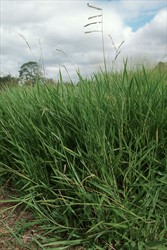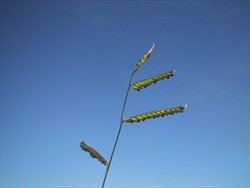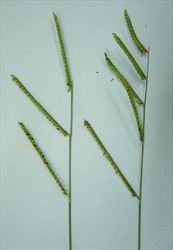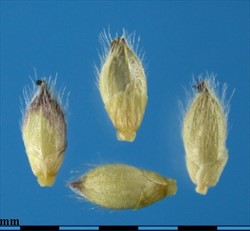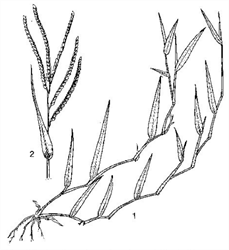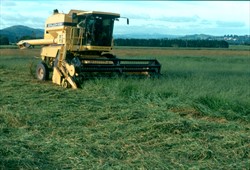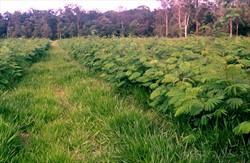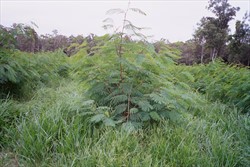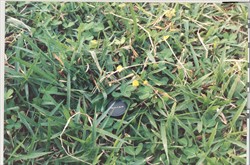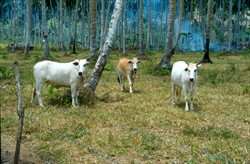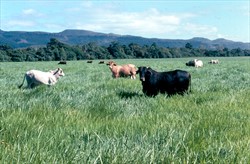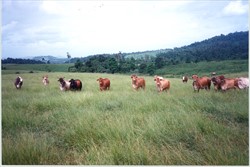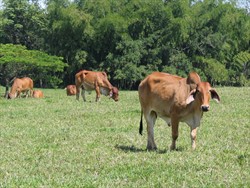Urochloa decumbens
Tropical Forages
Urochloa decumbens (Stapf) R.D. Webster
Basionym: Brachiaria decumbens Stapf
Family: Poaceae (alt. Gramineae) subfamily: Panicoideae tribe: Paniceae subtribe: Melinidinae.
Low-growing sward-forming perennial, 30‒45 (‒60) cm deep; culms decumbent or semi-erect, 50–150 cm long, rooting at lower nodes in contact with moist soil; sometimes shortly rhizomatous. Leaf sheaths tight, terete or somewhat compressed, keeled upwards, more or less finely hirsute; leaves blades narrowly lanceolate, 7‒15 (‒20) mm wide, 5–25 cm long, bright green, moderately hairy; ligule a fringe of hairs. Inflorescence a panicle comprising (1‒) 2‒5 (‒7) racemes, (1‒) 2‒5 (‒10) cm long borne along one side of a central axis 1‒10 cm long; rachis flat, broadly winged, 1‒1.7 mm wide, minutely pubescent on the front, and ciliate along the edges; racemes almost at right angles to the axis; spikelets borne adaxially in 2 intermeshing but distinct rows on the rachis. Spikelets elliptic, 4–5 mm long, subacute or acute, falling entire; glumes dissimilar, reaching apex of florets, thinner than fertile lemma; lower glume ovate, apex obtuse or acute, clasping; 0.33–0.5 length of spikelet, membranous, without keels, 9-veined; upper glume oblong, length of spikelet, membranous, without keels, 7-veined, surface pubescent, apex obtuse or acute. 280,000 seeds per kg.
Similar species
U. decumbens: culms decumbent, stoloniferous forming a denser cover; racemes 2–7, 1–5 cm long; rachis 1–8 cm long, flat, broadly winged, 1–1.7 mm wide; spikelets subacute or acute, 4–5 mm long, packed in 2 rows along rachis; lower glume ovate, 9-veined, apex obtuse or acute; upper glume oblong, membranous, 7-veined, surface pubescent, apex obtuse or acute.
U. brizantha: culms erect or geniculately ascending, more tufted habit; racemes (1–) 2–16, 4–20 cm long; rachis 3–20 cm long, crescentic in section, narrowly winged, 1 mm wide; spikelets subacute or acute, 4–6 mm long, packed in single row along rachis; lower glume ovate, 7–11-veined, apex obtuse or acute; upper glume oblong, cartilaginous, 7–9 -veined, surface glabrous or pubescent, apex obtuse, or acute.
U. ruziziensis: culms decumbent, stoloniferous forming a denser cover; racemes (3–) 5–7 (–9), 5‒10 cm long; rachis 4–12 cm long, broadly winged, foliaceous, 3‒5 mm wide, with rounded midrib, 2–3.5 mm wide; spikelets cuspidate, 4–5 mm long, packed in two rows along rachis; lower glume oblate, 11–13-veined, apex obtuse; upper glume oblong, membranous, 7-veined, surface pilose, hairy above, apex acute.
Asia: rumput signal (Malaysia); ya siknaentonnon, ya surinam (Thailand)
English: Kenya sheep grass, signal grass, Surinam grass
German: Surinamgras
Latin America: braquiarinha, braquiária, braquiária comum, braquiária de alho, capim braquiária, decumbens (Brazil); braquiaria australiano, braquiaria, decumbens, pasto alambre, pasto amargo, pasto braquiaria, pasto chontalpo, pasto de la palizada, pasto de las orillas, pasto peludo, pasto prodigio, zacate prodigio, zacate Surinam (Spanish)
Native:
Africa: Burundi, Democratic Republic of the Congo, Kenya, Rwanda, Tanzania, Uganda
Cultivated/naturalized:
Asia: Malaysia, Thailand
Australasia/Pacific: Australia, Vanuatu
Caribbean: Cuba, Trinidad
Central America: Costa Rica
South America: Brazil, Colombia, French Guiana, Paraguay, Peru, Venezuela
Forage
Mainly planted for permanent pastures in both grazed and cut-and-carry systems as fresh or conserved feed. It has been planted as grazed ground cover in plantations. Used in upland rice (Oryza sativa) systems in the Colombian savannas.
Environment
Gives good cover for erosion control on hillsides and for suppression of invasive species such as Chromolaena odorata.
Soil requirements
U. decumbens grows on most soil types except heavy clays, where waterlogging can be a problem. It is adapted to soils with pH as low as 3.5, being tolerant of high Al saturation and moderately tolerant of Mn, levels of which can be toxic to plants in very acid soils. It is more tolerant of high Al+++ than U. ruziziensis as it can detoxify Al in the root system by chelation with citrate and malate. It does not respond to lime when grown on acid infertile soils, but does respond strongly to improved fertility where deficiencies exist. The root system of U. decumbens has finer and longer roots than some other Urochloa species, facilitating superior uptake of P and N from the soil.
Moisture
While it will grow in areas with average annual rainfall as low as 700 mm, it is mostly grown in more humid areas with rainfall of 1,200–2,500 mm and higher, with a dry season up to 5 months. It stays green well into the dry season (better than U. brizantha). It can tolerate some short-term flooding but not even temporary waterlogging.
Temperature
U. decumbens grows best in temperatures above 19 ºC, so is most productive in the lowland tropics, or during the warmest part of the year in the subtropics or at higher altitudes. Leaves are burnt off by light frost but the plants recover.
Light
Intermediate tolerance to shade and suitable for ground cover under more open plantations. It is a common species under mature coconuts (>60% light transmission), but less tolerant of heavy grazing under reduced light than in full sun.
Reproductive development
Apomictic polyploids and sexual diploid. 'Basilisk' is an obligate aposporous apomictic tetraploid. Probably day-neutral in photoperiod response.
Defoliation
Very tolerant of heavy grazing. The leaf area recedes showing some bare soil under lower rainfall conditions but the stolons persist. Shading reduces tolerance of heavy grazing. Persistent under regular cutting, but very frequent cutting results in prostrate leaf growth which is difficult to harvest.
Fire
Usually not subjected to regular burning because leaf is normally heavily grazed or harvested before fires occur. However, U. decumbens can be burnt during the dry season and recovers rapidly from stolons and seed with the onset of rains.
Guidelines for establishment and management of sown forages.
Establishment
Large areas are easily planted with the large, free-flowing seed. Seed is frequently dormant for 6 months after harvest and should be stored or scarified before planting. Seed is broadcast at a rate of 2–4 kg/ha, then lightly harrowed and rolled. Commonly planted with a range of forage legumes. Can also be planted easily from vegetative sets although it does not spread and cover new land as quickly as U. humidicola.
Fertilizer
Tolerant of low fertility but responds strongly to N and P fertilizer. Animal production declines after a few years on acid soils cleared from rainforest unless maintenance fertilizer is applied every 2–3 years.
In Brazil, it is estimated that 40% of plant N comes from associated N-fixation under natural conditions, although the processes by which this occurs are not well understood.
Compatibility (with other species)
Many broadleaf species do not persist or persist weakly in signal grass by virtue of its good ground cover, aggressive growth and decumbent habit. Under lower defoliation pressure and on more fertile soils, it can form a mono-specific sward. Under heavier grazing with lower soil nitrogen but added phosphorus, it can combine well with creeping legumes.
Companion species
Grasses: not normally sown with other grasses
Legumes: Arachis spp., Centrosema molle, C. macrocarpum, Desmodium intortum, Grona heterophylla, G. heterocarpa subsp. ovalifolia, Stylosanthes guianensis var. guianensis.
On sandy soils in Colombian, Venezuelan and Brazilian savannas, Stylosanthes capitata. Under higher rainfall and heavy grazing, Neustanthus phaseoloides. On very acid, sandy soils in Guyana, a number of small, native Desmodium species.
Pests and diseases
Relatively free from diseases and pests including leaf-cutting ants but susceptible to spittlebugs (Aeneolamia, Deois and Zulia spp. Hemiptera: Cercopidae). Spittlebug susceptibility has greatly reduced the use of signal grass in tropical America, although mature stands may recover from attack. Susceptible to to spider mite (Tetranychus urticae). Numerous fungal diseases have been identified, the more serious being rust caused by Uromyces setariae-italicae, inflorescence blight caused by Claviceps sulcata, and foliar blight caused by Rhizoctonia solani.
Ability to spread
Spreads well and covers soil rapidly. Has become naturalized in large areas of the neo-tropical lowlands.
Weed potential
Has become an environmental weed by vigorously colonising disturbed environments.
Nutritive value
Moderately high (similar to other tropical grasses) but greatly dependant on the fertility status of the soil and age of regrowth. Intermediate to high digestibility (50–80%), chemical composition and intake. CP ranges from 9 to 20% depending on soil fertility and management, but can decline rapidly with age of leaf, from 10% at 30 days to 5% at 90 days. The inclusion of the legume G. heterocarpa subsp. ovalifolia increased the nitrogen concentration of the grass and the total N yield equivalent to 200 kg/ha N but the legume’s low palatability meant that little legume was eaten.
Palatability/acceptability
Moderately palatable but greatly depending on the fertility status of the soil and age of regrowth. It is generally rejected by equines. Livestock reject old or frosted grass .
Toxicity
Young cattle, sheep and goats can develop hepatogenous photosensitization although prevalence appears to be strongly related to environment. For example, it is of major concern in Brazil and Papua New Guinea but is unheard of in Vanuatu and rare in Australia. Transferring stock to pasture of different species can alleviate symptoms. Photosensitization in bovines can be avoided by a rotation of 2 weeks on and 2 weeks off the grass. Sporadic outbreaks have been related to mycotoxins from the saprophytic fungus Pithomyces chartarum, but also to saponins. Young, green leaves contain 5–10 times the saponin concentration of mature leaves indicating that U. decumbens pastures are likely to be more toxic during sprouting and early growth.
Feedipedia link
Dry matter
DM yields of around 10 t/ha/yr DM, but under heavy fertilizer application and ideal conditions, yields up to 30 t/ha are achievable. Production reduces dramatically in the dry season and ceases with the approach of winter in subtropical environments. On fertile soils in humid-tropical Vanuatu, it produced 29 t/ha/year DM in the first year of growth, but only 16 t/ha/year as fertility declined in the second year of growth. At high latitudes in Paraguay, yields were 14 t/ha/year.
Animal production
Heavily fertilized pastures can be highly productive (up to 1,300 kg/ha annual liveweight gain) due to the high yields of herbage and ability to carry high stocking rates. In humid-tropical Queensland, signal grass pastures fertilized with 336 kg/ha N and grazed at 7.7 head/ha produced 1,290 kg of liveweight gain. In Brazilian savannas, at stocking rates of 2.5 head/ha, 340 kg/ha/yr LWG have been recorded. In the humid tropics of Peru, at 4 head/ha, U. decumbens with G. heterocarpa subsp. ovalifolia gave LWGs of 380 g/hd/day and 640 kg/ha/yr. On more fertile soils with a reasonable legume component, gains of 450–600 g/head/day for individual cattle and 400–600 kg/ha/yr are commonly achieved.
Most ecotypes are apomictic tetraploids (2n = 4x = 36), although populations of sexual diploids (2n = 18) have been identified. Cross pollination can produce a sterile triploid hybrid (2n = 45). Apomictic tetraploids can act as male genitor to produce interspecific hybrids with U. ruziziensis or intraspecific hybrids with artificial tetraploids created from diploids. U. decumbens has also been used in 3-way interspecific breeding programs with U. brizantha and U. ruziziensis to produce a number of the cultivars listed below.
U. decumbens seed in Australia and Brazil can be produced by direct heading with high-capacity harvesters capable of handling the large bulk of decumbent leaves which hold fallen seed. At 16° S in Brazil, seed can be harvested 35–44 days after flowering, with 2 harvests per year (early and late in the wet season). High seed yields of 400–1,000 kg/ha are common in Brazil and Australia, but seed yields are commonly poor at latitudes close to the equator. Seed has a high percentage of dormancy following harvest. Primary dormancy is physiological, whilst long-term dormancy is mechanical, caused by a restriction of the seed coat. Dormancy may be broken by 6–9 months storage or by acid scarification .
Tolerates pre-emergence application of atrazine when establishing in weedy cultivation land. Controlled using glyphosate at 1.5‒2.9 kg a.i./ha.
- High productivity under intensive management.
- Withstands heavy grazing.
- Persists on low fertility, acid soils.
- Good seed yields and therefore relatively low cost seed.
- Susceptible to spittlebug attack in the New World tropics.
- Poor compatibility with many legumes.
- Low tolerance of poor drainage.
- Photosensitization in sheep, goats and young cattle.
- Not eaten by horses.
Bogdan, A.V. (1977) Tropical Pasture and Fodder Plants. Longman Inc., New York, USA. p. 54–57.
CIAT. (1992) Pastures for the tropical lowlands: CIAT’s contribution. International Center for Tropical Agriculture (CIAT), Cali, Colombia. hdl.handle.net/10568/54510
Lenné, J.M. and Trutmann, P. (eds). (1994) Diseases of Tropical Pasture Plants. CAB International, Wallingford, Oxon, UK.
Loch, D.S. (1977) Brachiaria decumbens (Signal grass)—a review with particular reference to Australia. Tropical Grasslands 11:141–156. bit.ly/3aQs6qw
Low, S.G. (2015) Signal Grass (Brachiaria decumbens) toxicity in grazing ruminants. Agriculture 5:971–990. doi.org/10.3390/agriculture5040971
Miles, J.W., Maass, B.L. and Valle, C.B. do (eds). (1996) Brachiaria: Biology, Agronomy, and Improvement. CIAT, Cali, Colombia. hdl.handle.net/10568/54362
Pedreira, C.G.S., Braga, G.J. and Portela, J.N. (2017) Herbage accumulation, plant-part composition and nutritive value on grazed signal grass (Brachiaria decumbens) pastures in response to stubble height and rest period based on canopy light interception. Crop and Pasture Science 68:62–73. doi.org/10.1071/CP16333
Peters, M., Franco, L.H., Schmidt, A. and Hincapié, B. (2003) Especies forrajeras multipropósito: Opciones para productores de Centroamérica. Centro Internacional de Agricultura Tropical (CIAT), Cali, Colombia. hdl.handle.net/10568/54681
Schultze-Kraft, R. and Teitzel, J.K. (1992) Brachiaria decumbens Stapf. In: Mannetje, L.’t and Jones, R.M. (eds) Plant Resources of South-East Asia No. 4. Forages. Pudoc Scientific Publishers, Wageningen, the Netherlands. p. 58–59. edepot.wur.nl/327785
Thomas, D. and Grof, B. (1986) Some pasture species for the tropical savannas of South America. III. Andropogon gayanus, Brachiaria species and Panicum maximum. Herbage Abstracts 56:557–565.
Valle, C.B. do, Savidan, Y.H. and Jank, L. (1989) Apomixis and sexuality in Brachlaria decumbens Stapf. Proceedings of the XVI International Grassland Congress, Nice, France, 4–11 October 1989. p. 407–408.
‘Basilisk’ Released in Australia (1966); ‘Brachiaria’ Cuba (1986/87); ‘Señal’ Panama (1986); ‘Chontalpo’ Mexico (1989); ‘Barrera’ Venezuela (1989); ‘Peludo’ Costa Rica (1991); 'Australiana' Brazil (1972); 'Amargo' Colombia (CPI 1694, CPI 6798, CIAT 606, BRA 001058, ILCA 10871). Collected in open grasslands of the Great Lakes Plateau in Uganda. Introduced into Australia in 1930 and selected for its very high DM yields in trials at South Johnstone during 1956–1966.
'IPEAN' (BRA 000191, CIAT 6012, IRI 562) was first introduced into Brazil in 1962 by the Instituto de Pesquisas Experimentais Agropecuárias do Norte (IPEAN). Because cv. Ipean is reproduced by stolons, it expanded slowly.
